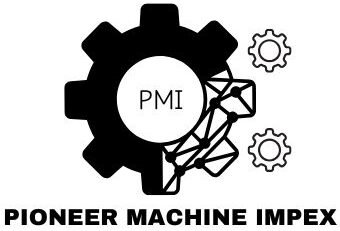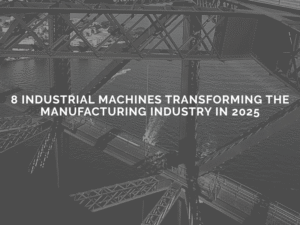The Era of Smart Manufacturing Is Here
In 2025, the world of manufacturing is undergoing a major transformation—fueled by the power of Artificial Intelligence (AI) and the Internet of Things (IoT). Industrial machines are no longer just mechanical tools performing repetitive tasks. They have become intelligent, connected systems that learn, adapt, and optimize operations in real time. This revolution is giving rise to smart manufacturing, where efficiency, precision, and automation reach unprecedented levels.
Manufacturers across industries—from automotive and aerospace to textiles and packaging—are embracing smart machines to stay competitive in a digitally driven world. These machines are capable of making autonomous decisions, detecting issues before they happen, and connecting entire production floors through smart networks. If you’re a business looking to increase productivity, reduce downtime, and gain real-time insights, then integrating AI- and IoT-enabled industrial machines is no longer optional—it’s essential for sustainable growth in 2025 and beyond.
What Is Smart Manufacturing?
Smart manufacturing refers to the use of digital technologies such as sensors, big data, AI algorithms, and cloud computing to improve manufacturing processes. Unlike traditional manufacturing, which relies heavily on manual input and isolated machines, smart manufacturing focuses on connected systems. Machines now communicate with each other and with human operators, sharing data and insights in real-time to make production more responsive and flexible.
The goal of smart manufacturing is not only to automate tasks but to enable intelligent decision-making. These advancements reduce waste, improve product quality, and significantly boost overall equipment efficiency (OEE). This approach is transforming factories into data-driven, self-correcting environments that can adapt to demand shifts and reduce operational costs.
AI in Industrial Machines: The Brain Behind Automation
Artificial Intelligence plays a central role in powering smart machines. AI enables machines to analyze large volumes of production data and make decisions that would typically require human intervention. For example, predictive maintenance systems use AI to identify patterns in machine performance and warn operators before a breakdown occurs. This not only prevents costly downtime but also extends the life of the machine.
Another key area where AI is used is in quality control. Vision-based AI systems can inspect products for defects with incredible speed and accuracy, far exceeding human capabilities. In some cases, AI can also suggest optimal machine settings based on product design and raw materials, making manufacturing far more efficient and customizable.
The Role of IoT in Smart Manufacturing
While AI acts as the brain, the Internet of Things (IoT) serves as the nervous system of smart factories. IoT involves embedding sensors and communication devices into industrial machines so they can collect and share data. These sensors monitor various parameters such as temperature, vibration, speed, and energy consumption.
The real-time data collected by IoT devices can be visualized on digital dashboards, allowing factory managers to make quick decisions based on live metrics. For example, if a certain machine begins to overheat, the system can trigger an automatic shutdown or reroute production to another unit without delay. This real-time responsiveness is one of the biggest advantages of integrating IoT in industrial machines.
How Smart Machines Are Improving Efficiency
One of the main reasons manufacturers are adopting AI and IoT technologies is to achieve higher levels of efficiency. Smart machines reduce manual errors, speed up production, and streamline resource usage. They can adjust their operation based on environmental conditions or material quality, ensuring consistency in output.
Additionally, AI algorithms analyze production history and future demand to optimize scheduling and inventory. This allows businesses to reduce overproduction and minimize waste. Machines that previously operated in silos are now part of a collaborative ecosystem, where every part of the process—from raw material input to final product packaging—is connected and optimized.
Smart Maintenance: Predict and Prevent Downtime
Maintenance has always been a crucial aspect of industrial machine performance. Traditionally, manufacturers followed scheduled maintenance cycles that often led to unnecessary downtime or missed early signs of wear and tear. Smart machines have completely changed this approach.
With predictive maintenance powered by AI and IoT, manufacturers can monitor the health of their machines in real time. Smart systems continuously analyze performance data and send alerts when any irregularity is detected. This proactive approach allows businesses to replace or service parts before they fail, significantly reducing unplanned downtime and improving overall productivity.
In addition to saving time and money, predictive maintenance also improves safety by reducing the risk of sudden mechanical failures that could endanger workers.
Customization and Scalability with Smart Machines
Modern manufacturing requires flexibility. Customers now expect products tailored to their needs, and production lines must be able to adapt without major overhauls. Smart machines make customization and scalability easier than ever before.
AI-driven software allows industrial machines to adapt their operation to different product specifications with minimal human intervention. This capability enables businesses to switch between product lines quickly and cost-effectively, making them more responsive to market demands.
Moreover, IoT platforms enable remote monitoring and updates. This means machine performance can be optimized or even upgraded via software patches without physically visiting the site—saving both time and labor
Real-World Applications Across Industries
The integration of AI and IoT in industrial machines is not limited to high-tech industries. Even traditional sectors such as textiles, food processing, and heavy equipment manufacturing are experiencing the benefits.
In automotive plants, smart robotic arms equipped with AI vision systems perform precision welding and assembly. In the packaging industry, smart machines automatically adjust packaging material based on product size and type. Meanwhile, in food production, IoT-enabled sensors maintain precise temperature and humidity conditions to ensure food safety.
Each of these real-world examples highlights the fact that smart machines are no longer futuristic concepts. They are practical tools being used today by companies large and small to stay ahead in a competitive marketplace.
Conclusion: The Future Is Smart and Connected
Smart manufacturing is no longer a buzzword—it is the standard for industrial success in 2025 and beyond. With the help of AI and IoT, machines are becoming more intelligent, efficient, and interconnected. They not only boost productivity but also enhance decision-making, improve product quality, and reduce operational risks.
For businesses looking to stay ahead of the curve, adopting smart machines is not just a smart choice—it’s a necessary one. Whether you’re starting a new facility or upgrading your current setup, investing in AI- and IoT-enabled industrial machines will future-proof your operations and keep you competitive in the years to come.


